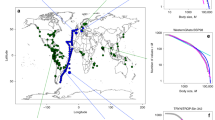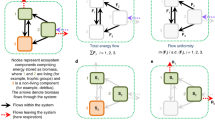Summary
Energy enters the arboreal epiphytic ecosystem by a number of different pathways. Primary producers such as algae and lichens, together with fungal and bark materials derived in the main from the tree substrate, form the major food components for populations of epiphytic grazing herbivores, notably psocids and collembolans.
This paper describes a series of experiments to determine empirically the combined influence of three climatic variables, temperature, light and relative humidity, on the uptake of 14CO2 by the main epiphytic alga, Pleurococcus. A model is produced which indicates that relative humidity is the most important of the variables, followed by light. Temperature appears to be relatively unimportant.
The model is discussed with respect to its realism, its predictive powers and its relationship to published data on forest productivity and grazing pressure by psocids.
Similar content being viewed by others
References
Bobek, B.: Influence of population density upon rodent production in a deciduous forest. Ann. Zool. Fennici 8, 137–144 (1971)
Broadhead, E.: The psocid fauna of larch trees in Northern England—an ecological study of mixed species populations exploiting a common resource. J. Anim. Ecol. 27, 217–263 (1958)
Broadhead, E., Thornton, I. W. B.: An ecological study of three closely related psocid species. Oikos 6, 1–50 (1955)
Broadhead, E., Wapshere, A. J.: Mesopsocus populations on larch in England— the distribution and dynamics of two closely-related coexisting species of Psocoptera sharing the same food resources. Ecol. Monogr. 36, 327–388 (1966)
Kirk, J. T. O.: Studies on the dependence of chlorophyll synthesis on protein synthesis in Euglena gracilis together with a nomogram for determination of chlorophyll concentration. Planta (Berl.) 78, 200–207 (1968)
New, T. R.: The relative abundance of some British Psocoptera on different species of trees. J. Anim. Ecol. 39, 521–540 (1970)
Odum, E. P.: Fundamentals of ecology. Philadelphia: Saunders 1971
Patterson, M. S., Greene, R. C.: Measurement of low energy beta emitters in aqueous solution by liquid scintillation counting of emulsions. Analyt. Chem. 37, 854–857 (1965)
Scholander, P. F., Evans, H. J.: Microanalysis of fractions of a cubic millimetre of gas. J. biol. Chem. 169, 551–560 (1948)
Shimshi, D.: A rapid field method for measuring photosynthesis with labelled carbon dioxide. J. exp. Bot. 20, 331–340 (1969)
Solomon, M. E.: Control of humidity with potassium hydroxide, sulphuric acid, or other solutions. Bull. ent. Res. 42, 543–554 (1952)
Turner, B. D.: The population dynamics of tropical arboreal Psocoptera (Insecta) on two species of conifers in the Blue Mountains, Jamaica. J. Anim. Ecol. 43, 323–337 (1974)
Whittaker, R. H., Woodwell, G. M.: Structure, production and diversity of the oak-pine forest at Brookhaven, New York. J. Ecol. 57, 155–174 (1969)
Author information
Authors and Affiliations
Rights and permissions
About this article
Cite this article
Turner, B.D. Energy flow in arboreal epiphytic communities. Oecologia 20, 179–188 (1975). https://doi.org/10.1007/BF00369030
Received:
Issue Date:
DOI: https://doi.org/10.1007/BF00369030




